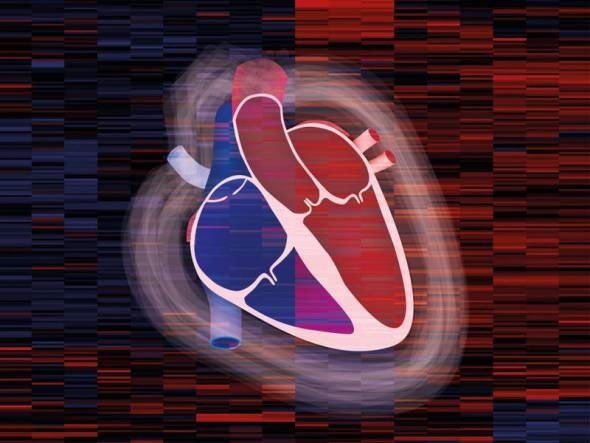
Researchers map first-ever proteome of healthy human heart
An atlas of the heart
A healthy heart beats about two billion times during a lifetime – thanks to the interplay of more than 10,000 proteins. Researchers from the Max Planck Institute of Biochemistry (MPIB) and the German Heart Centre at the Technical University of Munich (TUM) have now determined which and how many individual proteins are present in each type of cell that occurs in the heart. In doing so, they compiled the first atlas of the healthy human heart, known as the cardiac proteome. The atlas will make it easier to identify differences between healthy and diseased hearts in future.

Front: drawing of a cardiac muscle, Background: excerpt from a so-called “heatmap”, an overview of the proteins analyzed for the cardiac proteome. (image: Doll, Kraue, Menzfeld / MPIB)
Proteins are the molecular machines of cells, in which they perform a range of functions. They are produced by the cells based on blueprints stored in their DNA. Changes occurring at the DNA or protein level can lead to disorders. For such changes to be recognized as underlying causes of heart disease, it is important to know precisely which proteins are present in the healthy heart and in what quantities.
Protein map of the heart
The first such protein atlas of the heart was recently published in “Nature Communications” by a research team from Munich. The scientists determined the protein profile of cells in all the regions of the heart, such as heart valves, cardiac chambers and major blood vessels. In addition, they investigated the protein composition in three different cell types of the heart: cardiac fibroblasts, smooth muscle cells and endothelial cells. In this way, the researchers were able to map the distribution of proteins in the various regions of the heart. Using mass spectrometry, they identified nearly 11,000 different proteins throughout the heart.
Previous studies had focused for the most part only on individual cell types, or they used tissue from diseased hearts. “This approach has two problems,” says Sophia Doll of the MPIB and lead author of the study. “First, the results did not give a full picture of the heart across all its regions and tissues; and second, comparative data on healthy hearts were often missing. Our study has eliminated both problems. Now the data can be used as a reference for future studies.”
“Looking at the protein atlas of the human heart, you can see that all healthy hearts work in a very similar manner. We measured similar protein compositions in all the regions with few differences between them,” says Sophia Doll. We were also surprised to find that the right and left halves of the heart are similar, despite having quite different functions: the right half pumps oxygen-poor blood to the lungs, while the left half pumps oxygen-rich blood from the lungs to the body.
Sick vs healthy: identifying differences
In the next step, the team wanted to test whether the data from healthy hearts could serve as a control for detecting changes in diseased hearts. They compared their values with the cardiac proteomes of patients with atrial fibrillation, a very common rhythm disorder of the heart. The results indeed provided initial clues as to the cause of the disease. The tissue of the diseased hearts was most different in proteins responsible for supplying energy to the cells.
The comparison provided yet another interesting finding: Although the proteins involved in energy metabolism were changed in all the patients, those changes differed between individuals. “These findings show us how important personalized medicine is. Although all the patients had very similar symptoms, we see from the data that a different molecular dysfunction was responsible in each case. We need to learn to recognize and treat such individual differences − especially in cardiac medicine,” says Adjunct Teaching Professor Dr. Markus Krane, Deputy Director of the Department of Cardiovascular Surgery of the German Heart Centre Munich at TUM.
Nearly 11,000 proteins in less than two days
Together with his colleagues at the Department of Cardiovascular Surgery (Director: Professor Rüdiger Lange), Markus Krane has collected more than 150 tissue samples from over 60 cardiac operations and forensic samples. Using elaborate cell culture methods, they were able to extract the various cell types from them. This large amount of cardiac material was a crucial factor for studying the individual heart regions so precisely. Professor Matthias Mann, director of the Department of Proteomics and Signal Transduction at the MPIB, and his team carried out extensive mass spectrometric measurements. Thanks to advances in mass spectrometry and sample processing, the researchers are lighting the way towards personalized medicine.
The team at MPIB attaches great importance to precise, repeatable and fast analytical methods. They have improved the measuring technique to the extent that an entire heart region can now be determined in less than two days − twice as fast as before. This is crucial, especially for potential use on patients.





















.jpg)












No hay comentarios:
Publicar un comentario